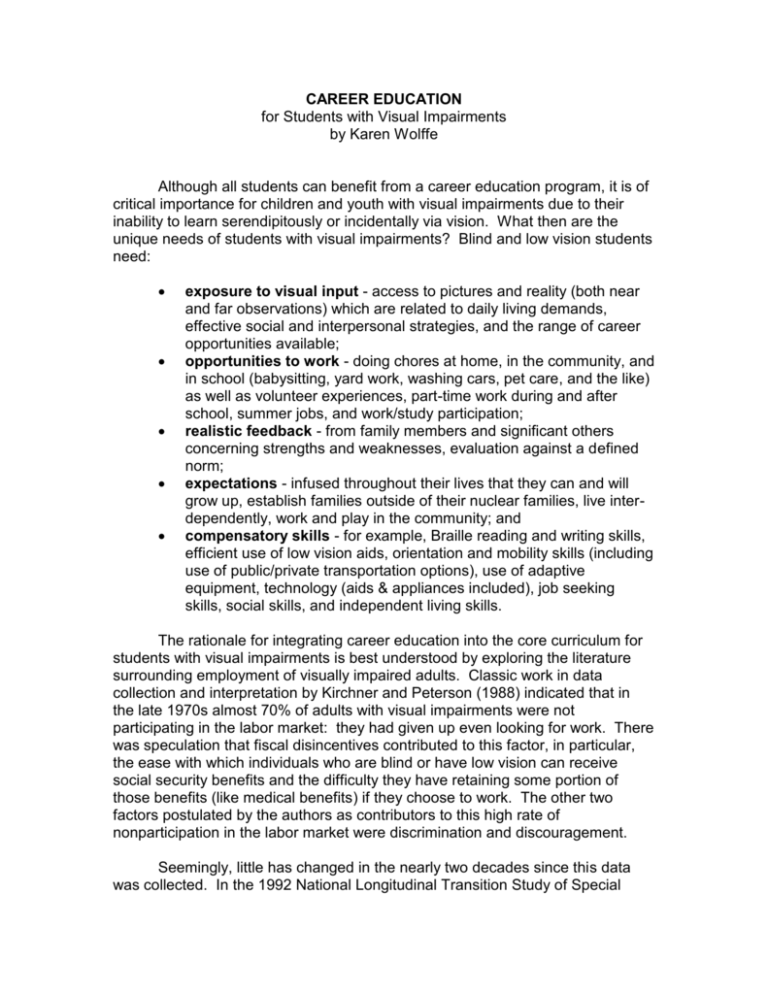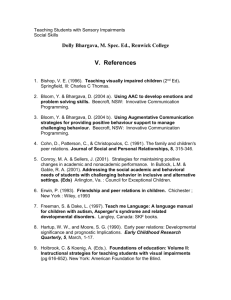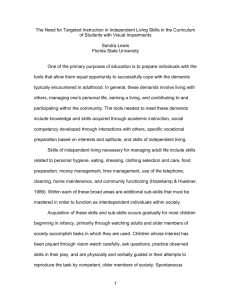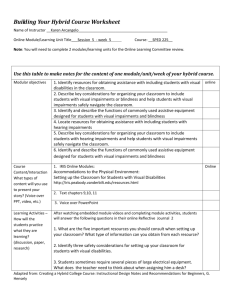Career Ed Article - SET-BC
advertisement

CAREER EDUCATION for Students with Visual Impairments by Karen Wolffe Although all students can benefit from a career education program, it is of critical importance for children and youth with visual impairments due to their inability to learn serendipitously or incidentally via vision. What then are the unique needs of students with visual impairments? Blind and low vision students need: exposure to visual input - access to pictures and reality (both near and far observations) which are related to daily living demands, effective social and interpersonal strategies, and the range of career opportunities available; opportunities to work - doing chores at home, in the community, and in school (babysitting, yard work, washing cars, pet care, and the like) as well as volunteer experiences, part-time work during and after school, summer jobs, and work/study participation; realistic feedback - from family members and significant others concerning strengths and weaknesses, evaluation against a defined norm; expectations - infused throughout their lives that they can and will grow up, establish families outside of their nuclear families, live interdependently, work and play in the community; and compensatory skills - for example, Braille reading and writing skills, efficient use of low vision aids, orientation and mobility skills (including use of public/private transportation options), use of adaptive equipment, technology (aids & appliances included), job seeking skills, social skills, and independent living skills. The rationale for integrating career education into the core curriculum for students with visual impairments is best understood by exploring the literature surrounding employment of visually impaired adults. Classic work in data collection and interpretation by Kirchner and Peterson (1988) indicated that in the late 1970s almost 70% of adults with visual impairments were not participating in the labor market: they had given up even looking for work. There was speculation that fiscal disincentives contributed to this factor, in particular, the ease with which individuals who are blind or have low vision can receive social security benefits and the difficulty they have retaining some portion of those benefits (like medical benefits) if they choose to work. The other two factors postulated by the authors as contributors to this high rate of nonparticipation in the labor market were discrimination and discouragement. Seemingly, little has changed in the nearly two decades since this data was collected. In the 1992 National Longitudinal Transition Study of Special Education Students (Wagner, D’Amico, Marder, Newman, & Blackorby, 1992), the authors reported over 60% of students with visual impairments were unemployed three years following graduation. Likewise, in a study of adults with visual impairments in Illinois, unemployment rates were near 60% and the authors presumed the survey sample over-represented employed persons and under-represented those who were out of the labor force (Harkins, Kirchner, Esposito, Chandu, & Istanbouli, 1991). Regardless of the exact numbers of youths and adults with visual impairments who are unemployed and/or no longer labor market participants, it is evident too many are not engaged in one of the most critical activities in our society: work. Recently, adults with visual impairments were surveyed in a national study to determine their employment concerns. The survey instrument was developed with both consumer and professional involvement. Respondents were asked to identify items of importance and levels of satisfaction with items. Items rated high in importance and low in satisfaction were identified as areas of concern. Their greatest concern was identified as a lack of job seeking skills training during their academic involvement. Also identified by this sample as significant problems were getting adequate information about career opportunities and having access to good placement assistance (Wolffe, Roessler, Schriner, 1992). Their input lends credibility to the need for a more structured approach to career exploration and job development. In order to break the cycle of high unemployment, it is essential that career education content be introduced throughout the educational process. Individuals who feel in control of their lives, who understand the complexities of job seeking and career development, are far more likely to become successfully employed than those who feel out of control due to lack of information about the world around them. The unique needs of students with visual impairments can best be met during their mandatory involvement in public education facilities. A properly infused career education curriculum can meet many of their needs. The following sections provide an overview of competencies necessary in such a curriculum. Essential components of a career education program Service providers and caregivers must understand the levels of lifelong career education: awareness, exploration, preparation, placement, maintenance, and mentoring. Specific competencies are detailed below. At each level (awareness, exploration, preparation, placement, maintenance, and mentoring), individuals with visual disabilities have unique needs in addition to generic, age-specific needs. The list below introduces competencies developed at each career level. It is not meant to be inclusive. Consider adding competencies specific to children, youth, and adults whom you know. Career Awareness: What young children need to learn about work What work is - energy expended to produce a product or provide a service, people work to contribute to the good of the greater society and to support themselves and their families within the community What kinds of jobs are being performed by members of a child’s family (this should include paying and nonpaying jobs) Developing work habits: following instructions, assuming responsibilities for self and possessions, being places on time, to whom to go for assistance, attending to tasks, completing tasks in a timely fashion, cooperative play and work, and so forth Developing work skills: learning to sort, put things together, cut, match to size or shape or texture, build, take apart, coordinate self and tools, use assistive devices, organizational skills, academic skills (speaking and listening, counting, letter recognition, and the like) Incidental learning: secular vs. religious holidays, seasons and representative activities, temporal concepts, social rules and mores, clothing worn by different workers, jobs performed behind-the-scenes, and so forth Becoming aware of different jobs within everyday experiences: the kitchen chores like washing & drying dishes, setting the table, refilling condiments, sweeping or mopping the floor, vacuuming, dusting; yard and garden work; washing and vacuuming family vehicles; pet care, and the like Role of chores: responsibility, reciprocity, self esteem, self worth, skills development Career Exploration: What middle school students need to learn for work Increased demands for organizing time (family, community, religious activities, extracurricular and school activities in balance) Increased responsibilities at home and in the community (volunteerism, paid work for family members and neighbors; work for school, band, clubs) Increased demands for skill development (academic skills, computer skills, communication--both spoken and written, physical prowess, alternative techniques related to visual impairment) Full understanding of work performed by family members, significant others, and key community workers Exploration into identified areas of vocational interest (reading, informational interviews, field trips, guest speakers, job shadowing) Further development of work habits (attendance, punctuality, cooperation, following complex instructions--both written and oral, time & space management) Ability to articulate interests, abilities, and liabilities (self awareness) Career Preparation: Competencies high school students must acquire Well developed academic skills (listening, speaking, reading, writing, arithmetic, science, history, et cetera) Values clarification Ability to set personal and vocational goals Understanding of resources (how to allocate time, money, materials, space, and energy) Well developed interpersonal skills (sociability, ability to work on teams, teach and lead others, negotiate and work with different kinds of people) Ability to acquire, evaluate, and use information; organize and maintain data files; communicate with and use computers efficiently Ability to select, use, and maintain equipment and tools (high, medium, and low technology) Well honed thinking skills: ability to think creatively and to problem solve Flexibility and self-reliance High levels of self-esteem Ability to correlate interests, abilities, and values to career options Job seeking skills and job search skills Work experience (volunteer or paid) Career Placement: Critical concerns for young adults in transition Work experiences (paid, if at all possible) during and after school Refinement of work-related skills and habits Access to information from adults in chosen fields (internships, apprenticeships, job shadowing) Further focusing and refining of interests and experiences to career goals Preparation for postsecondary education/training Participation in meaningful, career-related postsecondary training Networking for post graduation support Life/career planning Work, work, work The final career stages, maintenance and mentoring, are entered into in adulthood and at retirement from the work force, respectively. In the maintenance stage, adults work at jobs related to their career goals. They engage in continuing education, both in formal classes and through experiential learning on-the-job, and they advance as their talents dictate and opportunities avail themselves. Ideally, even before retirement-age, adults begin to mentor younger workers and teach them what they need to know to be successful in their chosen field. Certainly, after retirement, mentoring is a wonderful activity for older citizens to participate in, which enables them to share their wisdom. It is important that individuals with visual impairments know about all stages of the career development model and expect to be involved throughout their lives. An integrated career education program involves students as well as their families, school and adult services representatives, and concerned citizens from the larger community. Without involvement from all of these parties, there will be oversights in content and experiential learning opportunities. Business and community leaders can help teachers and students better understand the demands of the local labor market as well as the resources of the community. Parents and siblings can help reinforce and teach individuals with disabilities the critical life skills they will need in order to live successfully outside of their family homes. Teachers and adult service providers can help individuals with disabilities and others in their communities understand the impact of disabling conditions and help students develop the compensatory skills to overcome physical, emotional, cognitive, or sensory limitations. In addition, professionals can help students understand and access adaptive equipment and other reasonable accommodations for community access. References Harkins, D., Kirchner, C., Esposito, R., Chandu, F., & Istanbouli, M. (1991). Report from a study of issues and strategies toward improving employment of blind or visually impaired persons in Illinois. New York: American Foundation for the Blind. Kirchner, C. & Peterson, R. (1988). Employment: Selected characteristics. In C. Kirchner (Ed.), Data on blindness and visual impairment in the U.S. (2nd ed.). New York: American Foundation for the Blind. Wagner, M., D’Amico, R., Marder, C., Newman, L., & Blackorby, J. (1992). What happens next? Trends in postschool outcomes of youth with disabilities. Menlo Park, CA: SRI International. Wolffe, K., Roessler, R., & Schriner, K. (1992). Employment concerns of people with blindness or visual impairments, Journal of Visual Impairment & Blindness, 86(4), 185-187. Note: Published in Howe’s Now, Vol. 1, No. 4; The Council of Schools for the Blind: COSB newsletter September, 1995; and in the Summer 1996 issue of RE:view, 28(2), pp. 89-93.











